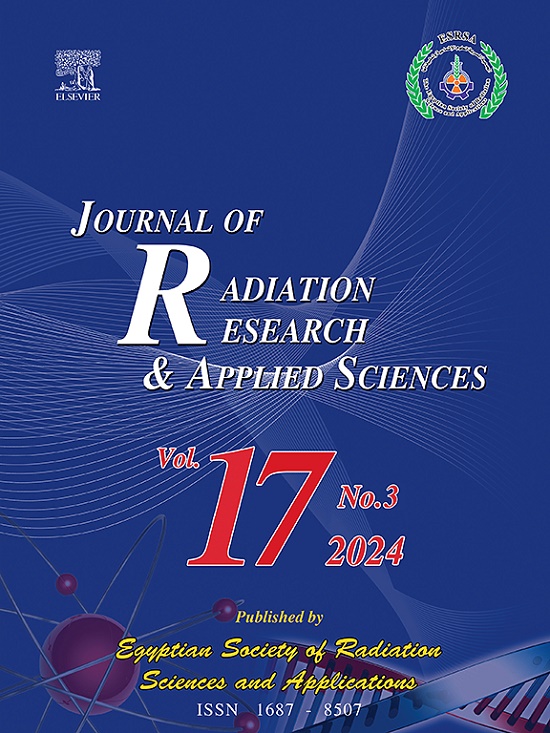Real-time dosimetry in lung cancer radiotherapy using PET imaging of positrons induced by gold nanoparticles
IF 2.5
4区 综合性期刊
Q2 MULTIDISCIPLINARY SCIENCES
Journal of Radiation Research and Applied Sciences
Pub Date : 2025-02-17
DOI:10.1016/j.jrras.2025.101361
引用次数: 0
Abstract
Radiation therapy (RT) is a potent lung cancer treatment. Real-time dosimetry improves precision and minimizes damage to healthy tissues. However, challenges persist due to invasive, low-resolution, or limited applicability of real-time dosimetry methods. The study aims to use gold nanoparticles (AuNPs)-induced pair production to acquire PET (Positron Emission Tomography) images during lung tumor radiotherapy and assess their feasibility for real-time dose monitoring. The GATE Monte Carlo code was employed to create a simulation of PET imaging for lung tumors with different levels of AuNP (2%, 4%, 6%, 8%, and 10% by weight (wt%)) during radiotherapy with 6 MV, 10 MV, and 15 MV photon beams. The quality of images was evaluated by utilizing signal-to-noise ratio (SNR) and contrast-to-noise ratio (CNR). Additionally, the root mean square error (RMSE) was calculated to evaluate differences between the normalized intensity volume histogram (nIVH) from PET images and the reference normalized dose volume histogram (nDVH). The study found that increasing AuNP concentrations in the tumor had minimal impact on CNR, SNR, and RMSE values for 6 MV photon beams. For 10 MV beams, CNR and SNR remained stable up to 8 wt%, but increased beyond this. For 15 MV beams, CNR and SNR values were constant at 4 wt% or lower but improved when exceeding 4 wt%. The lowest RMSE values for 15 MV beams were observed at concentrations of 4 wt% or higher. PET imaging with a 10 MV photon beam achieves acceptable dosimetric accuracy with at least 8 wt% AuNPs. Additionally, incorporating AuNPs at 4 wt% or higher concentrations in lung tumors allows for real-time dose monitoring during radiotherapy with a 15 MV photon beam.
金纳米粒子诱导正电子PET成像在肺癌放射治疗中的实时剂量测定
放射治疗(RT)是一种有效的肺癌治疗方法。实时剂量法提高了精度,并最大限度地减少了对健康组织的损害。然而,由于实时剂量测定方法的侵入性、低分辨率或适用性有限,挑战仍然存在。该研究旨在利用金纳米颗粒(AuNPs)诱导的对生成来获取肺肿瘤放疗期间的PET(正电子发射断层扫描)图像,并评估其用于实时剂量监测的可行性。采用GATE蒙特卡罗代码,在6 MV、10 MV和15 MV光子束放射治疗期间,对不同水平AuNP(按重量计为2%、4%、6%、8%和10%)的肺肿瘤进行PET成像模拟。利用信噪比(SNR)和噪声对比比(CNR)评价图像质量。此外,计算均方根误差(RMSE)来评估PET图像的归一化强度体积直方图(nIVH)与参考归一化剂量体积直方图(nDVH)之间的差异。研究发现,增加肿瘤中AuNP浓度对6 MV光子束的CNR、SNR和RMSE值的影响最小。对于10mv波束,CNR和SNR在8wt %以内保持稳定,但在此基础上有所增加。对于15 MV波束,CNR和SNR值在4 wt%或更低时保持不变,但当超过4 wt%时有所改善。在浓度为4 wt%或更高时,观察到15 MV光束的最低RMSE值。10 MV光子束PET成像达到可接受的剂量学精度,至少8wt % AuNPs。此外,在肺肿瘤中加入4 wt%或更高浓度的AuNPs,可以在放射治疗期间使用15 MV光子束进行实时剂量监测。
本文章由计算机程序翻译,如有差异,请以英文原文为准。
求助全文
约1分钟内获得全文
求助全文
来源期刊

Journal of Radiation Research and Applied Sciences
MULTIDISCIPLINARY SCIENCES-
自引率
5.90%
发文量
130
审稿时长
16 weeks
期刊介绍:
Journal of Radiation Research and Applied Sciences provides a high quality medium for the publication of substantial, original and scientific and technological papers on the development and applications of nuclear, radiation and isotopes in biology, medicine, drugs, biochemistry, microbiology, agriculture, entomology, food technology, chemistry, physics, solid states, engineering, environmental and applied sciences.
 求助内容:
求助内容: 应助结果提醒方式:
应助结果提醒方式:


